
Dyne Therapeutics started the new year with proof-of-concept clinical data for experimental genetic medicines addressing two rare muscle diseases—one of which has no FDA-approved treatments. Now the biotech has $345 million as it looks toward key tests for both therapies.
Ahead of the Martin Luther King Jr. holiday weekend, Dyne closed a stock offering of 19.7 million shares priced at $17.50 each. In the prospectus, Dyne said the net proceeds of the stock offering will be combined with its existing capital to fund ongoing clinical development of the two clinical-stage programs, DYNE-101 and DYNE-251. Dyne CEO Joshua Brumm said that this year the Phase 1/2 studies in myotonic dystrophy type 1 (DM1) and Duchenne muscular dystrophy will each optimize the dose and dose regimen to test in a cohort of patients that could support regulatory submissions for the respective therapies.

At ViVE 2024, Panelists Share Prior Authorization Progress and Frustration in Payer Insights Program
At the Payer Insights sessions on Day 1 of ViVE 2024, a panel on prior authorization offered compelling insights from speakers who shared the positive developments in this area after years of mounting frustration. Speakers also shared challenges as they work with providers to figure out how policy developments and technology will work in practice.
“I think that our pathway to a regulatory approval globally is more validated now than it was for us prior to this data, and I think we’ll have an opportunity to explore those in meaningful ways for both programs,” Brumm said, speaking during a presentation at the J.P. Morgan Healthcare Conference in San Francisco last week.
Waltham, Massachusetts-based Dyne develops therapies based on antisense oligonucleotides, nucleic acids that correct the function of disease-causing genes. This modality has already yielded therapies for rare diseases, including neuromuscular disorders. Dyne aims to improve delivery of therapies to muscle tissue by linking a genetic payload to a targeting antibody. The company’s platform technology, called FORCE, can be applied to therapies targeting skeletal, cardiac, and smooth muscles. Dyne is initially focusing on therapies targeting skeletal muscle.
The DM1 therapy DYNE-101 is being evaluated in a Phase 1/2 study that enrolled 32 adults. With targeted delivery to muscle tissue, the therapy is intended to reduce toxic levels of the mutant RNA that drives this disease, which currently has no available treatments. The data reported earlier this month are from the multiple-ascending dose portion of the study. Initial results showed that dose-dependent delivery of the therapy to muscle tissue. In the high-dose group, the evaluable patients achieved an average 40% knockdown of the mutant RNA at three months compared to baseline levels. The preliminary results also showed signs of correction of the splicing defects of the disease as well as improvement in muscle function. Dyne reported its DM1 therapy was well tolerated and most of the adverse events were classified as mild or moderate.
Dyne is also in Phase 1/2 testing with DYNE-251, an experimental treatment for Duchenne muscular dystrophy. This inherited disease leads to a lack of dystrophin, a key muscle protein. Sarepta Therapeutics brought to market the first Duchenne therapies, drugs that use oligonucleotides to skip the Dyne aims to treat the disease with oligonucleotides that skip deletions in the string of exons that code for dystrophin. Like Sarepta’s first Duchenne therapy, the once-a-week infusion Exondys 51, Dyne’s therapy is also an exon skipper. But Dyne believes that the ability of its therapy to target muscle tissue and promote exon skipping in the nucleus of the cell can enable muscle cells to create more complete and functional dystrophin protein. Furthermore, the company says its technology enables therapies that offer less frequent dosing.

When Investment Rhymes with Canada
Canada has a proud history of achievement in the areas of science and technology, and the field of biomanufacturing and life sciences is no exception.
Preliminary results of the Duchenne study showed DYNE-251 achieved delivery into muscle cells. Also, at the six-month mark, the once-a-month dosing of the Dyne therapy achieved a greater than two-and-a-half times expression of dystrophin compared to once-weekly Exondys 51. This comparison is not from a head to head test. Chief Medical Officer Wilden Farwell said Dyne is comparing the results of its drug to published results for the Sarepta therapy. In its study, DYNE-251 was well tolerated and most of the adverse events reported in the study were mild or moderate, Farwell said. Sarepta’s lineup of Duchenne treatments includes Elevidys, the gene therapy that won accelerated FDA approval last year. Farwell said new exon-skipping approaches are needed and Dyne’s drug could be used in conjunction with a gene therapy.
At the end of the third quarter, Dyne’s cash position was about $150 million. Combined with the new capital from the stock offering, Brumm said the company has capital to support the company through 2025. Dyne expects to have data updates for DYNE-101 and DYNE-251 in the second half of this year.
Dyne’s next disease target is facioscapulohumeral muscular dystrophy (FSHD), another rare muscle disease with no FDA-approved therapies. Brumm said both DM1 and FSHD are comparable in size to the cystic fibrosis market, each affecting between 40,000 and 50,000 patients in the U.S. and about 70,000 patients outside the U.S. The market opportunity in DM1 and FSHD, combined with the opportunity in Duchenne, has Brumm projecting Dyne achieving $20 billion to $30 billion in peak revenues for those three programs. That’s if they are able to reach the market. But Brumm added that the data so far validate Dyne’s FORCE technology in skeletal muscle, paving the way for the company to expand on applications of the technology to other muscle types, such as cardiac muscle.
“We’re looking forward to finally kind of opening up the aperture a bit beyond DM1, DMD, although we’re squarely focused, and I know the dynamos are very focused on making sure we get these drugs to patients,” Brumm said. “But we have the opportunity now to expand that a little bit and think about other ways we can leverage FORCE for patients globally.”
Public domain image by Flickr user Berkshire Community College Bioscience Image Library












